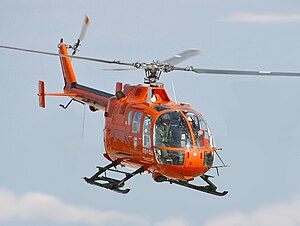
Back بي أو 105 Arabic MBB Bo 105 Azerbaijani Bölkow Bo 105 BS MBB Bo 105 Czech Bölkow Bo 105 German MBB Bo 105 Spanish امبیبی بو ۱۰۵ Persian Bölkow Bo 105 Finnish Bölkow Bo 105 French MBB Bo 105 Galician
| Bo 105 | |
|---|---|
 A Bo 105 flying with Luftrettung Bundesministerium des Innern | |
| General information | |
| Type | Light utility helicopter |
| National origin | West Germany |
| Manufacturer | Messerschmitt-Bölkow-Blohm (MBB) |
| Status | In service |
| Primary users | Republic of Korea Army |
| Number built | 1640 (total)[1] 1404 (German production)[1] |
| History | |
| Manufactured | 1967–2001[2][3] |
| Introduction date | 1970 |
| First flight | 16 February 1967 |
| Variants | Eurocopter EC135 |
The Messerschmitt-Bölkow-Blohm Bo 105 is a light, twin-engine, multi-purpose helicopter developed by Bölkow of Ottobrunn, West Germany. It was the first light twin-engine helicopter in the world, and the first rotorcraft that could perform aerobatic maneuvers such as inverted loops.[4][5] The Bo 105 features a hingeless rotor system, a pioneering innovation in helicopters when it was introduced into service in 1970. Production of the Bo 105 began at the then-recently merged Messerschmitt-Bölkow-Blohm (MBB).
The main production facilities for producing the Bo 105 were located in Germany and Canada; due to the level of export sales encountered, additional manufacturing lines were set up in Spain, Indonesia, and the Philippines.[6] MBB, acquired by DASA in 1989, merged its helicopter division with that of France's Aérospatiale to form Eurocopter in 1992 (rebranded Airbus Helicopters since). The latter continued production of the type until 2001. The Bo 105 was formally replaced in Eurocopter's product range by the newer Eurocopter EC135. By the close of production, over 1400 had been produced in Germany, and with license production 1640 had been produced in total.
- ^ a b Cite error: The named reference
hamelwas invoked but never defined (see the help page). - ^ Cite error: The named reference
eads-1was invoked but never defined (see the help page). - ^ Cite error: The named reference
euro 40was invoked but never defined (see the help page). - ^ Moll 1991, p. 96.
- ^ looping capability Archived 17 November 2015 at the Wayback Machine according to the German Air Force museum at Gatow
- ^ Moll 1991, pp. 103–104.